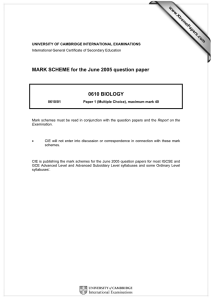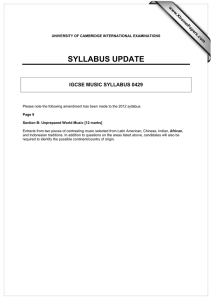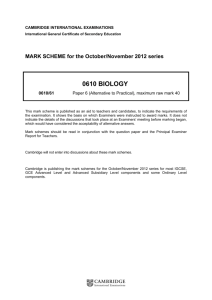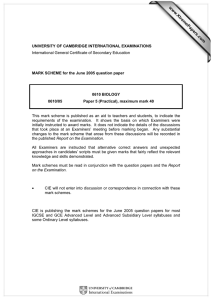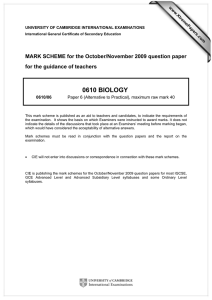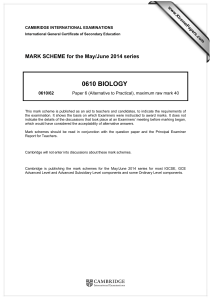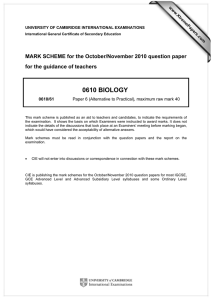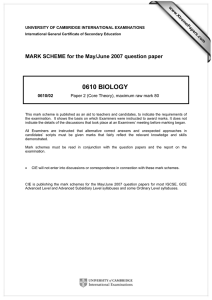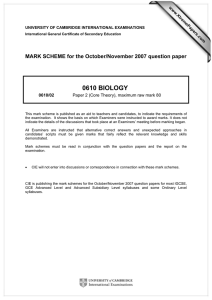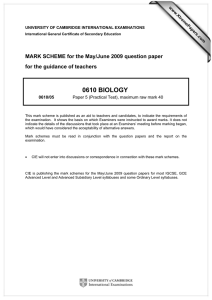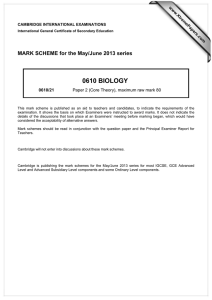www.XtremePapers.com
advertisement
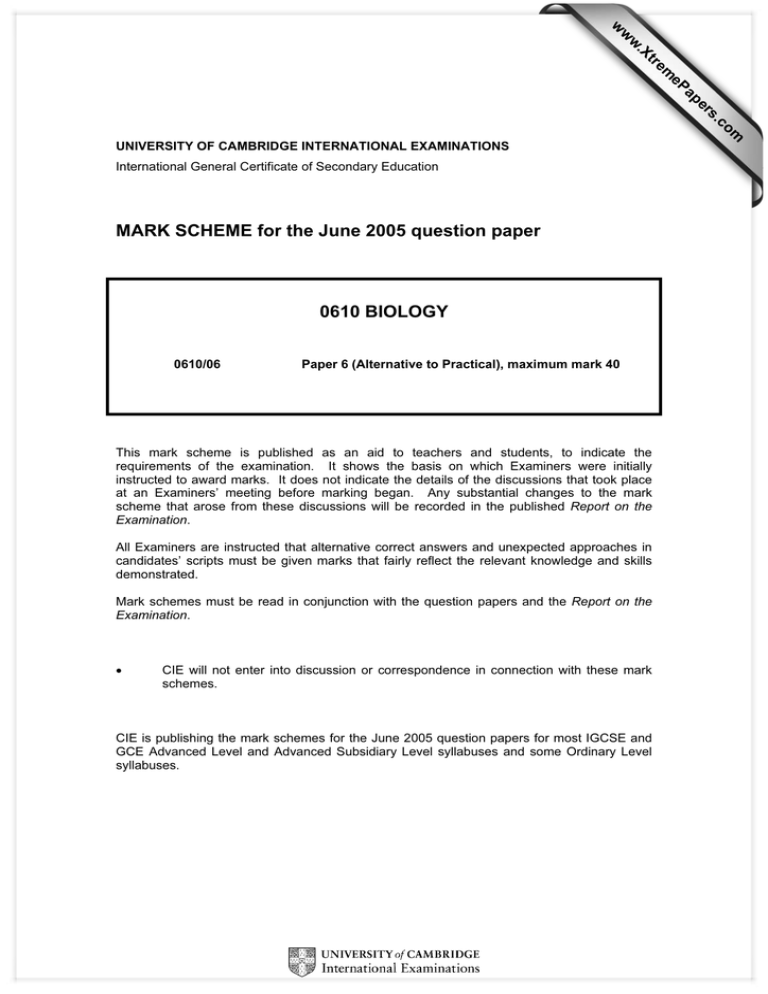
w w ap eP m e tr .X w International General Certificate of Secondary Education MARK SCHEME for the June 2005 question paper 0610 BIOLOGY 0610/06 Paper 6 (Alternative to Practical), maximum mark 40 This mark scheme is published as an aid to teachers and students, to indicate the requirements of the examination. It shows the basis on which Examiners were initially instructed to award marks. It does not indicate the details of the discussions that took place at an Examiners’ meeting before marking began. Any substantial changes to the mark scheme that arose from these discussions will be recorded in the published Report on the Examination. All Examiners are instructed that alternative correct answers and unexpected approaches in candidates’ scripts must be given marks that fairly reflect the relevant knowledge and skills demonstrated. Mark schemes must be read in conjunction with the question papers and the Report on the Examination. • CIE will not enter into discussion or correspondence in connection with these mark schemes. CIE is publishing the mark schemes for the June 2005 question papers for most IGCSE and GCE Advanced Level and Advanced Subsidiary Level syllabuses and some Ordinary Level syllabuses. om .c s er UNIVERSITY OF CAMBRIDGE INTERNATIONAL EXAMINATIONS Grade thresholds for Syllabus 0610 (Biology) in the June 2005 examination. maximum mark available Component 6 40 minimum mark required for grade: A C E F 28 19 13 10 The threshold (minimum mark) for B is set halfway between those for Grades A and C. The threshold (minimum mark) for D is set halfway between those for Grades C and E. The threshold (minimum mark) for G is set as many marks below the F threshold as the E threshold is above it. Grade A* does not exist at the level of an individual component. June 2005 IGCSE MARK SCHEME MAXIMUM MARK: 40 SYLLABUS/COMPONENT: 0610/06 BIOLOGY Paper 6 (Alternative to Practical) Page 1 1 (a) Mark Scheme IGCSE – June 2005 Syllabus 0610 Paper 6 (i) Completion of table tissue used volume of oxygen collected from sample/cm³ samples A B C D potato 4.5 6.5 0 0 liver 8.0 10.0 0 0 Correct values only. Ignore units in table. One mark per row;; [2] (ii) L - labeling; [x - axis A, B, C, D clearly labelled] [y - axis volume of O2 evolved cm3] S - suitable scale; [must fill more than half of grid, space for all letters even if no bar for C and D] P - plotting accuracy; [+- 0.5 mm i.e. half a square - all correct for A and B samples] B - bars separate and same width; [R if bars touching] [4] (iii) 1 speed of reaction 2 volume of gas/O2 produced 3 calculation liver faster more vigorous more reactions higher/larger/more 1.8 times more almost double 3.5cm3 more Accept comparison or comparative point - er. potato slower less vigorous less reactions lower/less no O2 is definite - R 1.8 times less almost half 3.5cm3 less [Max: 2] (iv) 1 A one piece and B many (small pieces); 2 link with surface area [A smaller/B larger]; 3 interior of large piece not reacted or converse or more enzyme/catalase released from small pieces/more reactant or more collisions if appropriate/AW; [Max: 2] (b) control for comparison to show an enzyme was involved/enzyme becomes denatured/deactivated/destroyed/AW; [1] (c) rekindle a glowing splint/glow brighter; [1] [Total: 12] © University of Cambridge International Examinations 2005 Page 2 2 (a) (b) Mark Scheme IGCSE – June 2005 Syllabus 0610 drawing: O clear outline; [single line - allow detail of spots but no shading] S good size and correct shape; [detail of petals and overall shape] A detail of stamens; [3 stamens, accurate and double line for filament] G detail of carpel; [bilobed stigma and above stamens and double structure below stigma down towards ovary] [4] Labels: X correct location and label line to anther; Y correct location and label line to stigma; Z correct location and label line to style; [3] (i) reducing sugar: add Benedict’s [reagents]; heat/boil/warm; starch: add iodine (solution)/iodine/I2 (ii) from blue to green/yellow/orange/red; (c) (i) (i) [3] [1] size of grains with unit [mm or cm] accept range 52-57 mm/÷magnification 200; actual size in mm or cm; accept range 0.26 to 0.285 mm [2] (ii) rough surface/hooks/not smooth/spikes/thorns/horns/projections; (d) Paper 6 [1] 1 choice of one type/same species of flower with different colour varieties/artificial flowers/coloured cards; [not petals alone]. 2 arrange flower(s) in separate colour blocks/in separate areas/places; 3 record the number of visits/observe where most insects visit; [easy point] 4 set time period specified e.g. minutes or hours; [‘days’ are too long] 5 keep other variables constant e.g. water/turgidity of flowers/background/time of day/AVP; 6 repeating experiment; [Max: 4] (ii) odour or scent or smell/shape e.g. resemble female insect/detail of flower to attract insect e.g. honeyguides or markings on petals/brightly coloured bracts or sepals/reference to UV light for moths/AVP; [1] [Total: 19] © University of Cambridge International Examinations 2005 Page 3 3 (a) (i) Mark Scheme IGCSE – June 2005 Syllabus 0610 two from: seedling in light/clear box leaves/cotyledons large broad ignore thick leaves with petiole/stalk [not colour] stem/stalk wider/shorter/thicker roots more growth normal whole seedling shorter/thicker apical tip/bud seedling in dark/black box small/narrow ignore thin leaves without petiole/stalk narrow/longer/thinner less etiolated taller/thinner no apical tip/bud [Max: 2] (ii) any four from: 1 idea of repeats/more seeds/more boxes; 2 grown under same temperature; 3 same species/same number/same age or size; 4 same watering/humidity/AW; 5 grown in same substrate/cotton wool; 6 measurements – calculate average/mean; (b) Paper 6 [Max: 4] any three from: 1 grows/curved/bending towards light slit/light source; [not moves] 2 unequal growth/AP; 3 shows phototropic response; 4 +ive/positive phototropic response to light; 5 reference to auxin/AP [Max: 3] [Total: 9] © University of Cambridge International Examinations 2005
